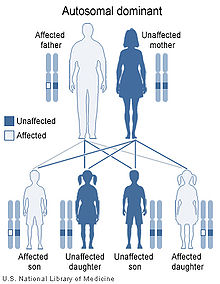- Hajdu–Cheney syndrome
-
Hajdu–Cheney syndrome Classification and external resources 
Hajdu-CheneyOMIM 102500 DiseasesDB 31486 MeSH D031845 Hajdu–Cheney syndrome, also called acroosteolysis with osteoporosis and changes in skull and mandible, arthrodentoosteodysplasia and Cheney syndrome,[1] is an extremely rare autosomal dominant congenital disorder[2][3] of the connective tissue characterized by severe and excessive bone resorption leading to osteoporosis and a wide range of other possible symptoms. Approximately 70 cases have been reported worldwide.
Contents
Characteristics
Hajdu–Cheney syndrome causes short stature and extreme bone flexibility. The disorder can also cause mild cognitive delays, such as delayed speech acquisition. Fetuses with Hajdu–Cheney syndrome often will not be seen to unclench their hands on obstetrical ultrasound. They may also have low set ears and their eyes may be farther apart than on a usual child, called hypertelorism. Children's heads can have some deformities in their shape and size (plagiocephaly). Early tooth loss and bone deformities, such as serpentine tibias and fibulas, are also common in those affected.
Genetics
 Hajdu–Cheney syndrome has an autosomal dominant pattern of inheritance.
Hajdu–Cheney syndrome has an autosomal dominant pattern of inheritance.
Hajdu–Cheney syndrome is inherited in an autosomal dominant pattern.[2] This means that the defective gene responsible for the disorder is located on an autosome, and only one copy of the gene is sufficient to cause the disorder, when inherited from a parent who has the disorder.
Mutations within the last coding exon of NOTCH2 that remove the PEST domain and escape the nonsense-mediated mRNA decay have been shown to be the main cause of the Hajdu–Cheney syndrome.[4][5][6]
Treatment
Since about 2002, some patients with this disorder have been offered drug therapy with bisphosphonates (a class of osteoporosis drugs) to treat problems with bone resorption associated with the bone breakdown and skeletal malformations that characterize this disorder.
References
- ^ Online 'Mendelian Inheritance in Man' (OMIM) 102500
- ^ a b Crifasi, P. A.; Patterson, M. C.; Bonde, D.; Michels, V. V. (Jun 1997). "Severe Hajdu-Cheney syndrome with upper airway obstruction". American Journal of Medical Genetics 70 (3): 261–266. doi:10.1002/(SICI)1096-8628(19970613)70:3<261::AID-AJMG9>3.0.CO;2-Z. PMID 9188663.
- ^ Brennan AM, Pauli RM (May 2001). "Hajdu--Cheney syndrome: evolution of phenotype and clinical problems". Am. J. Med. Genet. 100 (4): 292–310. doi:10.1002/1096-8628(20010515)100:4<292::AID-AJMG1308>3.0.CO;2-4. PMID 11343321.
- ^ A Simpson, Michael; Irving, Melita D; Asilmaz, Esra; Gray, Mary J; Dafou, Dimitra; Elmslie, Frances V; Mansour, Sahar; Holder, Sue E et al. (2011). "Mutations in NOTCH2 cause Hajdu-Cheney syndrome, a disorder of severe and progressive bone loss". Nature Genetics 43 (4): 303–305. doi:10.1038/ng.779. PMID 21378985. http://www.nature.com/ng/journal/vaop/ncurrent/full/ng.779.html. Retrieved 2011-03-07.
- ^ Isidor, Bertrand; Pierre Lindenbaum (2011). "Truncating mutations in the last exon of NOTCH2 cause a rare skeletal disorder with osteoporosis". Nature Genetics 43 (4): 306–308. doi:10.1038/ng.778. PMID 21378989. http://www.nature.com/ng/journal/vaop/ncurrent/full/ng.778.html.
- ^ Majewski, J; Schwartzentruber, Jeremy A.; Caqueret, Aurore; Patry, Lysanne; Marcadier, Janet; Fryns, Jean-Pierre; Boycott, Kym M.; Ste-Marie, Louis-Georges et al. (2011). "Mutations in NOTCH2 in families with Hajdu-Cheney syndrome". Hum Mutat: n/a–n/a. doi:10.1002/humu.21546. PMID 21681853.
External links
- Acroosteolysis dominant type at Orphanet
- Information on Hajdu–Cheney syndrome from a parent
Osteochondropathy (M80–M94, 730–733) Osteopathies endocrine bone disease: Osteitis fibrosa cystica (Brown tumor)infectious bone disease: Osteomyelitis (Sequestrum, Involucrum) · Sesamoiditis · Brodie abscess · PeriostitisBone density
and structureDensity / metabolic bone diseaseContinuity of boneOtherFibrous dysplasia (Monostotic, Polyostotic) · Skeletal fluorosis · bone cyst (Aneurysmal bone cyst) · Hyperostosis (Infantile cortical hyperostosis) · Osteosclerosis (Melorheostosis)OtherChondropathies OtherBoth lower limb: hip (Legg–Calvé–Perthes syndrome) · tibia (Osgood-Schlatter disease, Blount's disease) · foot (Köhler disease, Sever's disease)Categories:- Autosomal dominant disorders
- Congenital disorders
- Rare diseases
- Syndromes
- Genetic disorders with OMIM but no gene
- Genetic disorder stubs
Wikimedia Foundation. 2010.
